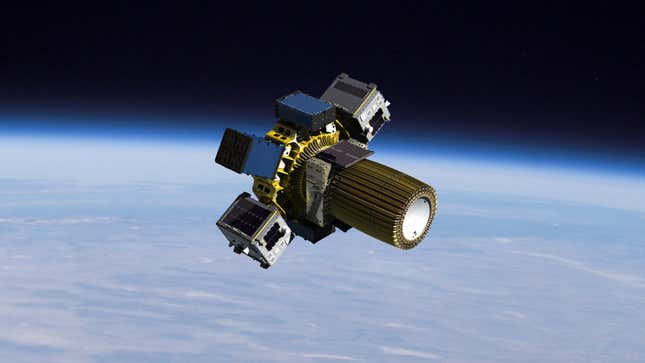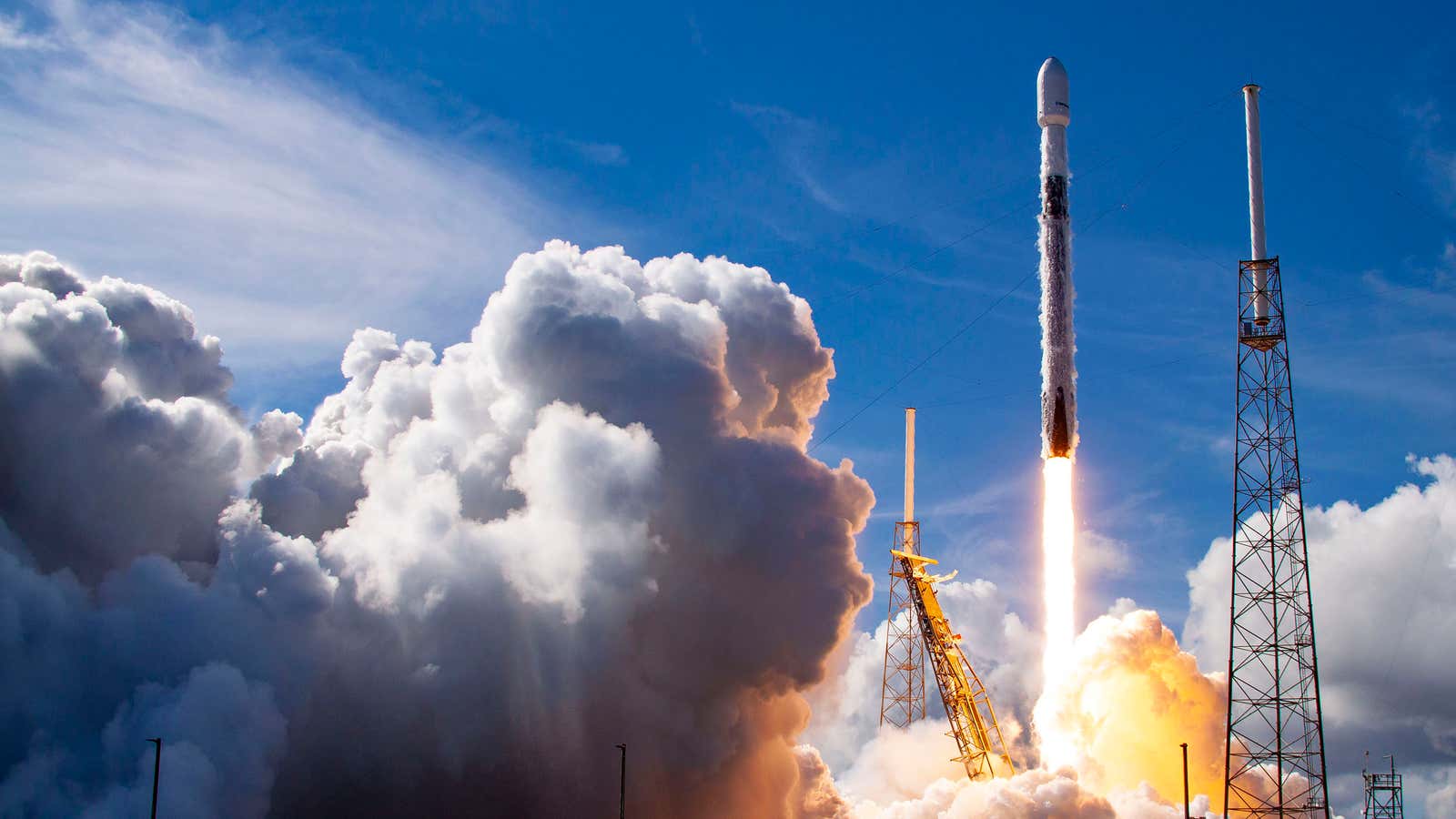SpaceX set a new world record for the number of spacecraft launched by a single rocket, after deploying 143 satellites on a Jan. 24 launch from Kennedy Space Center.
The mission, dubbed Transporter-1, was the first in a series of “rideshare” launches offered by Elon Musk’s space company. Here’s what it looks like when 143 spacecraft are tucked into the Falcon 9 rocket’s nosecone:
They scale from refrigerator-sized satellites for SpaceX’s own Starlink internet network and dishwasher-sized space radar satellites from the US company Capella and the Finnish firm ICEye, down to 48 earth-imaging satellites about the size of a large toaster oven from Planet, a company that collects data on every inch of the earth’s landmass.
The launch represents a convergence of space industry trends. SpaceX’s reusable rocket boosters give it spare capacity to fly additional trips into space—this booster had flown four times previously, launching everything from a Korean military satellites to International Space Station supplies. And packing as many small satellites as possible into a single rocket is a key way to drive down the cost of putting them in orbit, in turn enabling more ambitious business plans in orbit.
In fact, this mission increased the number of active satellites in orbit by 4%, helping push forward aspirations that the space economy can drive growth back on earth.
But there’s just one wrinkle with this strategy, epitomized with yesterday’s mission: A single rocket launch can drop off satellites at roughly one altitude, in a specific orbit around the planet. Many spacecraft will need to be somewhere else to do their job at peak efficiency—and efficiency is vital in space, where margins are thin. That metaphorical last mile—it might be hundreds of kilometers, or it might be a few degrees of orbital inclination—is a real obstacle. For operators, it means putting satellites in less than optimal positions, or investing in expensive propulsion systems to boost their spacecraft to the correct spot.
Space transportation has a last mile problem, and venture-backed firms are vying to solve it.
Are you down with OTVs?
Grant Bonin, a business development executive at the launch broker Spaceflight, says this dynamic is one reason the cost of operating satellites has not fallen dramatically, despite cheaper and more frequent launches. “One of the biggest costs is propulsion,” Bonin told Quartz. “If you want to buy at retail, [the cost is] punishing. If you want to buy at cost, you have to develop it. It is difficult to have great, highly-capable onboard propulsion.”
That’s why Spaceflight is one of several companies developing what you might call a tugboat for space—an “Orbital Transfer Vehicle,” or OTV. If these vehicles become common, satellite operators could spend less time and money on rocket engines for their satellites, and also realize cost reductions from by making shared flights more suitable for all kinds of spacecraft.
Spaceflight’s OTV, called “Sherpa,” made an unpowered debut on this SpaceX rideshare mission. On similar missions planned later this year, the company intends to demonstrate a version equipped with thrusters.

Even without propellant, dedicated rideshare flights like provide a use-case for the Sherpa. First, there are cost reductions: SpaceX offers a berth in its rocket for about $1 million, so buying a slot on the Sherpa promises savings for small satellite operators; on this flight, the OTV will carry 13 satellites, alongside two hosted payloads.
Another important use is traffic management: As dozens of small satellites are deployed from a rocket, it can be difficult for their operators to ascertain—using radar, GPS and other remote-sensing data—which satellite is theirs and where exactly it is. After a 2018 SpaceX rideshare launch, some satellites went unidentified for months, in part because of technical problems with prototype and student-built spacecraft.
The Sherpa includes separate deployment systems for each satellite and sensors to “give customers near real-time data of when their spacecraft separates,” according to Jeff Roberts, a Spaceflight engineer.
This launch is also among the first to use a radar network built by LeoLabs, a private space surveillance company, to track the satellites as they deploy. Even so, at least one organization, Hamilton University, voiced pre-launch fears that a small research satellite it operates might intersect with the crowd of new arrivals.
A war of tugs
Other OTVs available for hire include a vehicle from Rocket Lab, which offers regular launches of small and medium satellites on its Electron rocket from New Zealand. The company’s space tug is called Photon, and it performed its first on-orbit demonstration in September 2020. Later this year, the company plans to use a Photon to transport a small NASA satellite into orbit around the moon.
Momentus, a Silicon Valley start-up, is also focused on OTV technology. Its Russian founder and CEO resigned today to overcome US government restrictions ahead of an attempt to go public this year. Its Vigoride made a demonstration flight in 2019, but the company delayed plans to launch on this rideshare mission after the Federal Aviation Administration called for an interagency review that includes questions about the company’s ownership.
One key differentiator between these efforts are the technologies they use to propel themselves through the vacuum of space; recall it is the most costly part of the system.
Rocket Lab relied on technology it developed for its rocket. Momentus uses a water-based propulsion system apparently developed by founder Mikhail Kokorich. Spaceflight, meanwhile, has hired two specialist companies, Benchmark Systems and Apollo Fusion, to develop two different systems, one driven by chemical fuel and the other by electricity—the former for quickly raising altitude, and the latter for ultra-efficient alterations to the satellite’s orbit around the earth.
Both Momentus and Spaceflight’s OTVs are designed to fly on a variety of rockets, but the outsize role of SpaceX in offering these rideshare missions highlights the risk of the business model: Existing rocket makers can make their own OTVs if they think demand is there. Rocket Lab CEO Peter Beck said that building Photon was “not a huge jump, to be honest. We had to add solar panels and few other spacecraft specific systems.”
In other words, it would not be hard for bigger launch firms to build their own OTVs if it turns out to be a popular business model or even a useful loss leader. United Launch Alliance, the Boeing/Lockheed Martin joint venture, seen as among the more conservative space firms, has considered developing reusable space tugs.
Different ways to view the “last mile” market
Momentus has told potential investors that it hopes to climb up the spacecraft value chain, building larger OTVs that are capable of carrying spacecraft to much higher orbits or even to the moon, acting as satellites by carrying payloads in space over longer time periods, or as a platform to service and refuel existing satellites. That could leave it competing with everyone from established firms like Northrop Grumman to other start-ups like Astroscale.
For Rocket Lab’s Beck, the Photon is intended to solve a broader problem in the space ecosystem by simplifying the task faced by technology companies that want to put their products in orbit around the earth.
“Launch is pretty much a solved problem,” he said in 2020. “You’ve pretty much got everything you need. Quickly after you solve that, you’re left with the next big problem: It takes a huge amount of expertise and teams to build a business in orbit. How do you affordably get a business or an idea into orbit? That’s the bit that Photon aims to try and solve.”
Spaceflight’s Bonin says his firm, which began as broker that matched satellites with rockets, sees the OTV as one part of its suite of products that ease the path forward for satellite developers.
“Our vision as a company is about being a flexible space transportation solution for people,” he says. “Sometimes we don’t need an OTV. Sometimes the most important thing we can do is let the customer decide between 10 rockets. Sometimes it’s help them finance their launch deal. We want to be the Swiss army knife for getting people into space.”
Satellite operators are just happy to have an array of firms fighting to make their lives easier. They envision a world where they can put more processing power and bigger sensors on their spacecraft instead of bulky propulsion systems, where tugs can make positioning a constellation of satellites a matter of a two or three launches instead of a dozen.
“As an operator and someone who needs to launch a whole bunch of satellites, this brings optionality and hopefully it brings the prices down,” Payam Banazadeh, the CEO of space radar operator Capella, told Quartz last year. “Couple [frequent SpaceX launches] with space tugs, you have access to space twice a month and potentially to a wide array of orbits…It’s a matter of time and the right company with the right capabilities doing it.”
